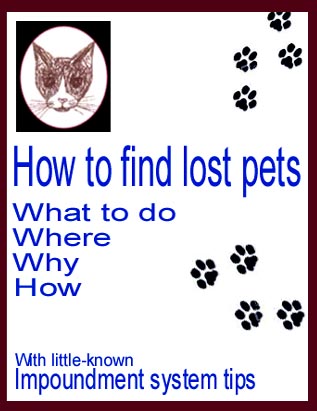
Home
![]()
Who -- What --
Where -- Why -- How
HOW TO FIND
RESEARCH DEALERS AND RESEARCH LABS
Click here
for printer-friendly page
Research Dealers and Research Labs in the U.S: Finding
America's legitimate research dealers and research labs is not
difficult. Simply 1) contact your local Federal offices and ask how to
get a copy of the latest Federal Register of Research Dealers and
Research Laboratories using animals in research, or 2) contact your
local Federal library depository and ask for information on the
current Federal Register of research dealers and research labs. Below
is the website address (URL) of the Government
Printing Office libraries which takes you to a map of all states
(currently undergoing upgrade). To find your local office(s), click on
the map of your state, or scroll to view library pdf files:
The Federal Register (which you get via your Federal offices phone
call)
http://grants.nih.gov/grants/olaw/olaw.htm
Visit the following nih webpage for information on noninvasive
bioimaging research technique(s):
ILAR Journal Volume 49(1): Noninvasive Bioimaging of Laboratory Animals at http://dels.nas.edu/ilar_n/ilarjournal/journal.shtml
"Posted:
December 21, 2007
The imaging modalities available for use with laboratory animals
provide a means to explore the molecular mechanism of several
diseases, minimize many of the limitations of static tissue-based
techniques, and, most importantly, decrease the numbers of animals
required. In fact, depending on the application, it is possible to
reduce the number of animals required per study by as much as 80% to
90%. This feature is noteworthy because, perhaps unique to the
ILAR Journal, there is an intentional effort to publish reviews
that include considerations specifically relevant to animal care and
use."
Click here for an NIH document on animal activists (current as of
Feb. 2008):
"December
20, 2006
A new Frequently Asked Question (FAQ) is now posted on the OLAW
website at:
http://grants.nih.gov/grants/olaw/faqs.htm#instresp_8.
This FAQ provides guidance on the roles of the Institutional Official
and the IACUC in developing plans to diminish the likelihood that
their institution or its employees will become targets of animal
activists.
Institutions are encouraged to review OLAW FAQs and make use of this resource. As necessary OLAW will update the site with new FAQs."
"Brochure Targets Investigators
June 19,
2006
OLAW has created a brochure intended to communicate to investigators
their responsibilities under PHS Grants Policy and PHS Policy on
Humane Care and Use of Laboratory Animals. What
Investigators Need to Know About the Use of Animals
provides a succinct resource for investigators to quickly
grasp the main expectations and requirements when using animals in
research supported by the PHS. The brochure may be accessed as a PDF
at
http://grants.nih.gov/grants/olaw/InvestigatorsNeed2Know.pdf
(PDF - 4 MB) or in Word at
http://grants.nih.gov/grants/olaw/InvestigatorsNeed2Know.doc
(MS Word - 47 KB). OLAW will provide institutions with enough copies
to disseminate to all of their investigators that work with animals.
Send requests, along with the number of copies needed, to
olaw@od.nih.gov,
and please be sure to provide your complete mailing address."
For more information, continue through this website documentation, and
visit the NIH website
Click here for how animals are killed in pounds and shelters
Popular Pet Products:
Edible Supplies
Online Catalogs
Cleaning and D.O.
2004, Copyright cT2, inc., Box 7164,
Minneapolis, Mn 55407
All rights reserved
Questions or comments,
.
If you find a broken link, please email . Thank you!
Additional keywords: animal control humane society county pound
city pound sheriff department animal shelter
police pound impoundment facility animal pound dog pound
Since
one little detail
may be the one that brings
your lost pet home,
plan to investigate
The tidbits you find will be invaluable for your efforts.
Most-comprehensive in scope,
This website info now available in book form:

Book pricing here
Popular
Pet Products:
Pet Training
Edible Supplies
Online Catalogs
Cleaning
and D.O.
This website contains a wealth of details your pet needs you to know. Take the time you need to study it thoroughly.
free newsletter
Please help
Thank you!
send feedback
l
Windows Quick Find
(mouse over)
l
pet
info articles
pet products
nature products
find all your pounds
all shelters
all no-kill shelters
reasons
- where
support this site
--any amount--
so we may continue
helping
get lost pets home
Healthy cat
litter
Dirt Dog robot

Your efforts will pay off.
Keep your search going while studying this website's information.